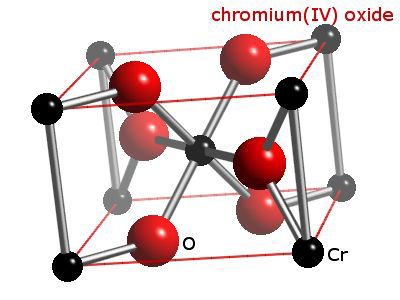Nanopaper Materials-Chromium Dioxide Powder-Cro2

Description
Chromium dioxide or chromium(IV) oxide is a synthetic magnetic substance once widely used in magnetic tape emulsion. With the increasing popularity of CDs and DVDs, the use of chromium(IV) oxide has declined. However, it is still used in data tape applications for enterprise-class storage systems. It is still considered today by many oxide and tape manufacturers to have been the most perfect magnetic recording particulate ever invented.
Chemical Name: Chromium(IV) oxide
Chemical Formula: CrO2
Synonyms
CrO2, chromium oxide, chromium(IV) oxide, chromdioxid, chromium dioxide, chromium dioxide (CrO2), chromium oxide (CrO2), dioxido de cromo, dioxyde de chrome, crolyn, magtrieve, accroxc, accroxr, chromium oxide (CrO2), chromium(IV)dioxide, chromiumdioxide, chromiumdioxide(CrO2), CAS#12018-01-8
Physical Properties
Pieces, powder and targets
Typical Applications
The crystal's magnetic properties, derived from its ideal shape anisotropy which imparted high coercivity and remanent magnetization intensities, resulted in exceptional stability and efficiency for short wavelengths, and it almost immediately appeared in high performance audio tape used in the standard audio cassette for which treble response and tape hiss were always problems. Unlike the spongy looking ferric oxides used in common tape, the chromium dioxide crystals were perfectly formed and could be evenly and densely dispersed in a magnetic coating; and that led to unparalleled low noise in audio tapes. Chrome tapes did, however, require a new generation of audiocassette recorders equipped with a higher bias current capability (roughly 50% greater) than that used by iron oxide to properly magnetize the tape particles. Also introduced was a new playback equalization setting (70 microseconds) that traded some of the extended high-frequency response for lower noise resulting in a 4–5 dB improvement in signal-to-noise ratio over ferric-oxide audio tapes. These bias and EQ settings were later carried over to "chrome-equivalent" cobalt-modified tapes introduced in the mid 1970s by TDK, Maxell, and others. Later research significantly increased the coercivity of the particle by doping or adsorbing rare elements such as iridium onto the crystal matrix or by improving the axial length-to-width ratios. The resulting product was potentially a competitor to metallic iron pigments but apparently achieved little market penetration.